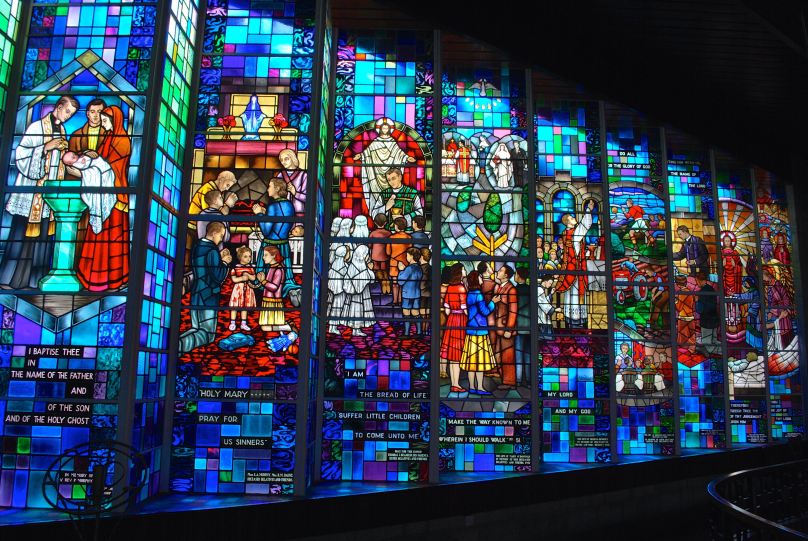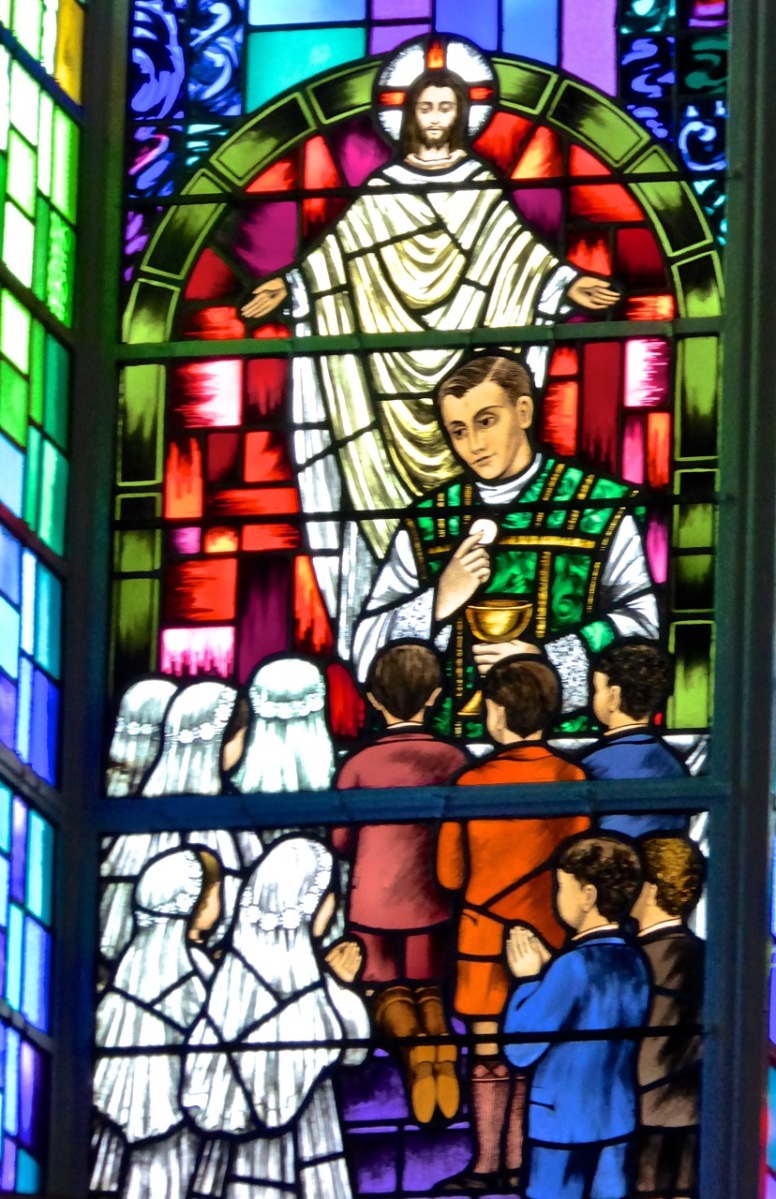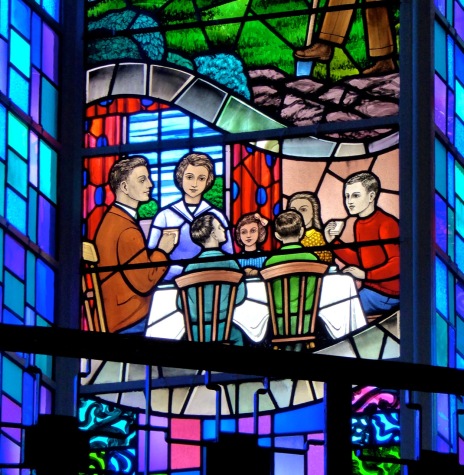It was the early 1960s and I was sitting in class in my convent school while Mother Francisca explained the purpose of our education and gave us a glimpse of our futures. “What we want for you, girls,” she said, “is to be Good Wives or Nuns.” This week, I landed back in that classroom with a bang. Did I visit my old school? No – I strayed into a time warp. In doing so I rediscovered part of my heritage I had almost forgotten and I met a brilliant young scholar who helped me access those dim memories again.
All Saints Catholic Church in Drimoleague is one of the most extraordinary buildings in West Cork. First of all, it’s a fine example of mid-century modern architecture (and there aren’t a lot of those in West Cork) and an engineering triumph. Built in the 1950s of concrete and limestone, its cavernous interior has no need for pillars: nothing intrudes between worshippers and altar. It’s like stepping into an enormous, curiously bright, almost empty box. Secondly, it has extraordinary artwork in the form of a giant mural behind the altar and a panel of stained glass windows above the balcony on the south wall. It was the stained glass that stopped me in my tracks.
The glass is laid out in a series of frames that takes the viewer from birth to death – no, beyond death, to heaven. The church was built in the 1950s and each frame represents the values of rural Catholic Ireland of that time. In a strange way it reminded me of a High Cross, in that the illustrations that we see on High Crosses were meant to tell a story – a biblical one in that case – and to instruct the viewer in the tenets of the religion. The purpose of this wall of glass was also educational – to provide a primer to mass-goers on the aspirations and actions that should guide their lives.
My parents, imbued with the message that the family that prays together stays together, developed an intermittent enthusiasm for saying the rosary. We would gather in the kitchen after dinner, each with our beads, and kneeling on the hard tiles we would tell off the Sorrowful or the Glorious Mysteries. The second frame shows just such a family, and I particularly love the toys on the floor and the statue of Mary on the mantlepiece. There’s a grandmother and a baby in a cot, and a little girl being inducted into the Mysteries by her older sister.
The next frame shows First Communion, with the girls in miniature bride outfits (as they are to this day) and the boys in their Communion suits with the short trousers and knee socks that all boys wore at that time. Since my godson in Dublin is about to make his First Communion I have been hearing about the process and I understand that apart from the length of the boy’s trousers not a lot has changed in 60 years.
The one that brought me back to Mother Francisca shows earnest young men and women gazing at a directional sign which shows them their choices – marriage or the religious life. That was it! To hammer home the point the top of the panel shows a wedding, a priest and a nun. I’m casting my mind over the group of girls I went to school with – we didn’t produce any nuns and while most of us married I can’t think of a single one who hasn’t worked – we count among us an ambassador, teachers and principals, a town planner, an artist, a college dean, office administrators, a medical doctor, an international expert on child protection, a veterinary nurse, a parliamentary reporter, a lawyer…the list goes on. But none of this was discussed at school: we had no career guidance, no aptitude tests, no encouragement of any kind to think of ourselves as people who would work for a living. What’s curious is that we developed those careers in the complete absence of any kind of conscious preparation for them at the secondary school level.
The sixth frame might be my favourite. It’s the ‘work, rest and play’ lesson. At the bottom of the frame a happy family sits around the tea table. Above them men work on the fields and on top those men are playing Gaelic football while their wives sit on a bench on the sidelines and chat to each other. Men were to head the family, work and play hard, and women were to provide the supportive role. I doubt if anyone foresaw when that glass was designed in the 1950s that in the next century (only a few days ago in fact) two Irish rugby squads – the men AND the women – would bring home the Six Nations Cup for Ireland.
The last three frames deal with end of life, including Last Rights, death, and reception into heaven – the reward for living the exemplary life presented in the stained glass wall.
If you grew up like I did in 1950s Ireland, or if you are interested in the art and architecture or the social history of this period, the Church of All Saints in Drimoleague tells a fascinating story. There is little available online about this church – I couldn’t even find out who designed the windows. But my research revealed that one other person was as struck as I was by this church, although in a more scholarly way. Richard James Butler is a gifted young art historian from Bantry who is completing doctoral studies at the University of Cambridge. We were lucky to hear him speak at the Bantry Historical Society recently on the subject of the courthouses of West Cork – a topic we had no idea could be as interesting until we heard his erudite and engaging presentation. He has written a paper, All Saints, Drimoleague, and Catholic visual culture under Bishop Cornelius Lucey in Cork, 1952-9, which will be published in the next issue of the Journal of the Cork Historical and Archaeological Society. I’ve had a sneak peak, thanks to Richard’s generosity in sharing his findings with a fellow enthusiast. His paper deals with the Catholic ethos within which that era of church construction operated, with the role of the local community in commissioning such an unusual edifice, with the enormous mural, and with the windows. It was only after communicating with Richard that I learned that the windows were the work of the Harry Clarke Studios* and how unusual they were for their day in not being concerned solely with images of saints, the life of Christ, or Mary. If you get a chance to read his paper when it’s published, do so – it may make you take a fresh look at the legacies of 1950s Ireland by which we are still surrounded.
* For a discussion of the difference between Harry Clarke windows and Harry Clarke Studio windows, see this post.













I must have missed this one the first time around… or simply and joyously enjoyed it anew.
I love the paragraph on women’s roles and your contemporaries education and life paths. The windows are stunning, and your commentary brilliant.
LikeLike
Well, I was certainly stunned by them, although not by the quality of the artwork! It is amazing, isn’t it, that despite the absence of expectations for us, we all went on to work.
LikeLike
https://www.google.ie/amp/s/amp.irishexaminer.com/breakingnews/lifestyle/homeandinteriors/cork-architect-the-unsung-hero-of-modernism-856730.html
LikeLike
What an excellent piece, Conor. Thanks so much for posting it.
LikeLike
Wonderful post Finola, thank you. Drimoleague to me was just the next station down the line from Dunmanway – I had no idea it sported such a remarkable building. It certainly reflects well on Harry Clarke’s legacy.
And what a great reminder of times past, and not so long ago either. It’s quite remarkable the way that the Catholic church governed people’s lives in Ireland. It’s only the present young generation that are growing up with freedom from guilt if they choose alternative paths. And to be fair the present church hierarchy are comfortable with that.
Even in the early 60s in my Catholic primary school in Birmingham half of the boys in my class stuck their arms in the air when asked who’d like to be a priest!
Loved this post Finola.
LikeLike
Finola,
A lovely piece which has awakened memories. Thank you.
I like your passing comment on architecture in West Cork.
R.
LikeLike
Ah…those Irish childhood memories!
Re the passing comment – do you mean the one about there not being much mid-century modernist architecture on West Cork? If you know of any buildings I’d love to see them.
LikeLike
Finola’s entry for the week.
Sent from AOL Mobile Mail
LikeLike
Very interesting post, Finola. I look forward to Sundays for the latest installment of your explorations– both those round about in your ramblings in the countryside, and those more interior ramblings in in the culture of your growing up and in your West Cork today.
LikeLike
Thanks so much for the kind comments, Susan. This one was fun to write!
If your travels bring you to West Cork it would be fun to meet up.
By the way, did you mean to insert the other comment, above? It looks like an email to someone?
LikeLike
Great article, the architect was the cork modernist Frank Murphy, he was very popular and completed a great number of modern buildings in Cork & county over the decades. Such as Thompson’s bakery, MacCurtain street. The IDL bottling plant, north mall. Number 1 south mall. Baltimore sailing club, Baltimore, Sacred heart school, Ballyphehan and Cork Simon community bought his listed modern home and converted it to their Cork branch. A well respected architect in his day. He won the RIAI Europa Nostra medal in 1975.
The RIAI planned an exhibition on his work when he passed away in 1994, but nothing came of it. Tom spading also noted him in ‘Cork’s 20th century architecture’ if you wish to read more. A scanned version is available fee online.
I am currently pulling together materials as i am researching him for my thesis in my final year studying architecture. I am also familiar with Richard Butler’s work- So im really glad i came across this! wonderful article!
LikeLike
What great additional detail – thank you so much for taking the time to comment. The Baltimore Sailing Club was refurbished last year with a new addition – I think Frank Murphy would like it.
LikeLike
It sounds like a fascinating church, I will try and visit when I am down that way, as it seems to be very unique. Lovely post too.
LikeLike
Thanks, Joan – well worth a visit!
LikeLike
As the child of Irish Catholic parents in New York in the 1950’s, I grew up with all the same advice but without the beautiful windows to illustrate it.
LikeLike
Thanks for your comment. Maybe it’s a universal experience for us Catholics!
LikeLiked by 1 person
What astonishingly beautiful windows and what a fascinating glimpse into a now vanishing world – and well done you girls!!!!
LikeLike
Parallel lives – the lives that the nuns and priests were describing and the lives we actually led. There was congruence in some bits (a lot of us said the rosary after tea in the 50s) and divergence in others.
LikeLike
Wonderful article, Finola. The stained glass panels – unknown to me before this – initially left me lost for words. I’ve seen quite a bit of stained glass in my time as you know, but I don’t ever remember encountering such a strong and prescriptive narrative that now seems both quaint and a bit disturbing. Fascinating!
LikeLike
Glad you liked it, David and that I was able to introduce you to a new set of windows! And such unique ones. Given your recent Communion photos, I thought this might indeed resonate with you.
LikeLike
The Harry Clarke studio connection is particularly fascinating. So many of the churches sadly do not acknowledge the artisans whose work is displayed.
LikeLike
You are so right! Because I couldn’t access the balcony the day I was there I don’t know if the Studios signed the windows, but I have certainly often seen windows that have no identifying signatures. I have also edited the post with a link to more information about the difference between Harry Clarke and Harry Clarke Studio pictures.
LikeLike
Finola I loved this report and the windows are beautiful.
LikeLike
Thank you, Lydia – so glad you liked it.
LikeLike
Reblogged this on West Cork History.
LikeLike